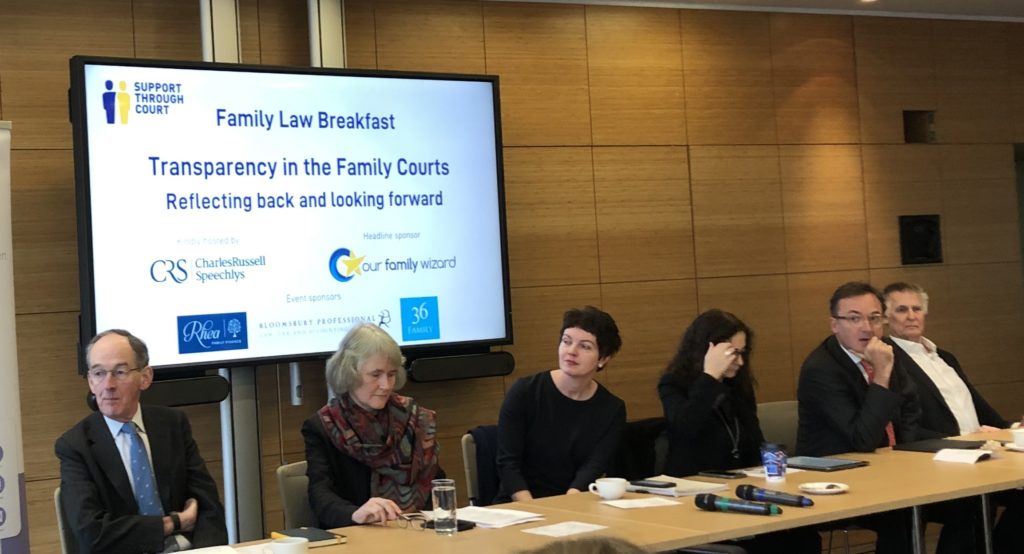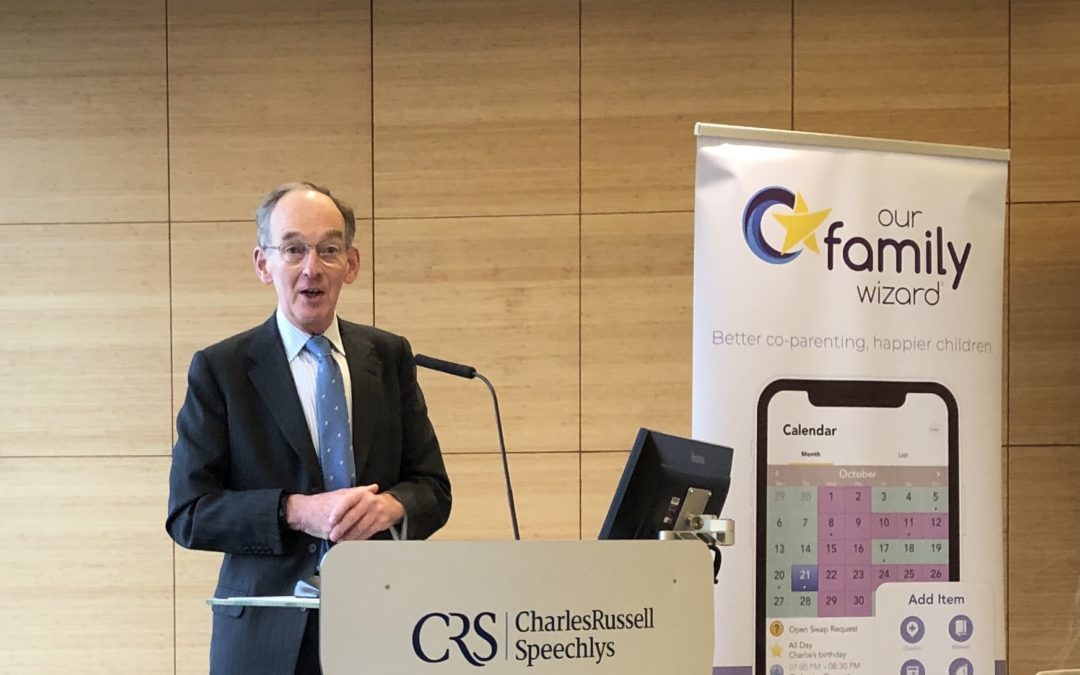For too long, transparency in the family courts had been put in the “too-difficult box”, but with the forthcoming court reporting pilot it was to be hoped that the right balance could be struck between confidence and confidentiality.
So said Sir Andrew McFarlane (above), giving the keynote speech at this year’s Support Through Court annual Family Law Breakfast, hosted by Charles Russell Speechlys at their London office last Tuesday, 17 January 2023.
‘Transparency in the Family Courts – Reflecting back and looking forward’ was the theme of this year’s event, which was also sponsored by Our Family Wizard, Bloomsbury Professional, The 36 Group, and Rhea Family Finance.
After an informal starter of tea, coffee, pastries and networking, the main breakfast consisted of a five-course menu, served in turn by representatives of a range of perspectives on the family justice system, chaired and introduced by Hannah Markham KC (The 36 Group).
Sir Andrew McFarlane, President of the Family Division, giving the keynote address, said transparency reform had been a long time coming but it had always seemed to sit in the “too-difficult box”. The problem was getting the right balance between confidence and confidentiality – squaring the circle between the confidence that comes from public scrutiny and transparency, and the vulnerability felt by children fearing exposure in the age of Google and social media.
It was entirely legitimate for the public to have some understanding of the work of the family courts, so they might have confidence in the process rather than thinking of it as the “secret family court” where everything was done on the back of an envelope with no proper scrutiny.
The Transparency Review in October 2021 had concluded that it was right to be open about what the courts were doing, but without identifying the individuals involved. The work of implementing its conclusions was being addressed by the Transparency Implementation Group (TIG) and its five sub-groups, dealing variously with the court reporting pilot, the anonymisation and publication of judgments, data collection, media engagement, and financial remedy cases.
The Transparency Reporting Pilot[1] was due to start on 26 January. It would begin with public law cases. If a reporter (defined as including both accredited press and legal bloggers) attended, the court would make a Transparency Order saying what they could and couldn’t report and who could or couldn’t be named.
A lot of effort had gone into developing the pilot, he said. But it would only work if journalists actually turned up. The pilot courts were in Cardiff, Leeds and Carlisle. (Carlisle had been chosen because it was the sort of place where, if the local press did report on a case, there was a higher risk of parties being recognised by its readers.) The pilot was intended to help allay the fear and apprehension among some judges.
Sarah Higgins, solicitor, of Charles Russell Speechlys, sounded a note of caution. There was a real conflict between the principle of open justice and that of client confidentiality. From a client’s perspective, what was best for them?
As for litigants in person, more information should help them. It was difficult to distil principles simply from reading judgments. But there was a difference between knowing what a case was about and identifying the people in it. It should not be an opportunity simply to “name and shame” anyone.
In cases involving domestic abuse there was a risk that fear of publicity might put off alleged victims, that they might be too frightened to go to court, especially after being told by the alleged perpetrator that no one would believe them.
More generally, fear of publicity might encourage parties to opt out of the court process. What effect might that have on future clients, or on the public’s confidence in the system? There was fear, too, that the press might sensationalise or trivialise family cases; it would be necessary to prevent public comments appearing under such reports.
Louise Tickle, award-winning freelance journalist (& member of the Transparency Project), responded on behalf of the press. As a reporter she had been contacted by numerous people about how they had been dealt with by the family justice system and the utter devastation it had caused when things went wrong. It was clear that there must be more scrutiny and transparency.
It would be great if journalists came to court more often, but it was very expensive to do so when there were so many restrictions on what could be reported. Practitioners should be friendly to journalists and help them: they were not out to hurt the parties involved, and a balance could nearly always be found.
Alexander Chandler KC, barrister specialising in matrimonial finance, discussed the question of transparency by reference to the somewhat whimsical conceit of the Muppet Christmas Carol.
The Ghost of Christmas Past showed how things had been prior to 2009, when the family division was like a different country, and all its courts sat in private as a matter of course. The Ghost of Christmas Present showed how things were now, after the rules had been revised to allow accredited press to attend most hearings, a position extended more recently to legal bloggers. But while the press could be there, they generally weren’t and what they could report was limited. Moreover, there remained uncertainty as to how open financial dispute cases should be, with different judges taking different approaches: for clients, it was like playing Russian roulette.
Now the Ghost of Christmas Future had appeared with a copy of the President’s paper Confidence and Confidentiality. Mr Justice Mostyn had had a Damascene conversion. Financial dispute cases were no longer part of a desert island or legal Alsatia.
So the question was, would Tiny Tim live? To find out, one awaited the third report from Judge Farquhar (chair of the Financial Remedies Court (FRC) sub-group of the Transparency Implementation Group). How far would it go? Sunlight was, of course, the best disinfectant. But too much transparency might have unintended consequences. Those who could afford to, might “go private” (ie to arbitration).
Stephen Adler, trustee of Support Through Court, said he appeared to be occupying the “graveyard” slot (which was perhaps appropriate after all the talk of ghosts).
His point was that, for litigants in person, transparency was just as important inside the court room as it was outside. According to MOJ figures, in two-thirds of private law family cases at least one of the parties was not represented. In domestic abuse cases, while 75% of applicants got legal aid for representation, only 25% of respondents got legal aid.
People felt the system was biased against them. Transparency meant not just scrutiny from outside but also understanding for those inside the court, as to what was going on. Both aspects needed to be covered, internal transparency as well as external transparency.

[1] Note. For more about the Transparency Reporting Pilot launching soon, see our New Guidance note – What to do if a reporter attends your hearing (with links to other information).
Featured images: photos by Paul Magrath.
We have a small favour to ask!
The Transparency Project is a registered charity in England & Wales run largely by volunteers who also have full-time jobs. We’re working hard to secure extra funding so that we can keep making family justice clearer for all who use the court and work within it. We’d be really grateful if you were able to help us by making a small one-off (or regular!) donation through our Just Giving page. You can find our page, and further information here.
Thanks for reading!
